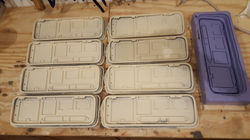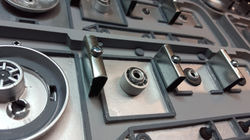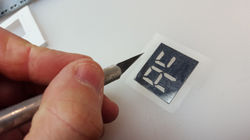top of page


Building
Han Solo in Carbonite
Full Size
 Step 1:The majority of the time spent on this project is in creating the eight side-panels. For my design, I took some creative liberties in the layout and embellishment of the panels. The panel design is not 100% movie accurate as I took some liberties with ready-made, low-cost details. In order to get started, you’ll need a rough pattern of the panel to use as a guide. |  Step 2:Since there are eight panels, I’ll be making a single panel (Master) and making cast replicas from it. In order to make the master, I used some scrap Masonite and bits of balsa and craft foam to make the panel. Screws and other embellishments were added to the master as well. |  Step 3:Pink foam was cut and sanded to create the appropriate bevel as the panels don’t sit flat, but instead tilt out. |
|---|---|---|
 Step 4:A final base layer of craft foam was cut and glued to the entire assembly. |  Step 5:In order to start the casting process, a box was made from foam core board to surround the part and catch the RTV silicone rubber. The box was built using hot glue and is slightly larger than my master panel. |  |
 |  Step 6:Once the mold is dry, I secured it onto a board with a duct tape strap so I can begin the casting process. The board and strap allow the mold to stay stiff and not twist or move during the casting process. |  Step 7:A two-part casting resin is used to for the fine detail. However, given the cost of this resin, I opted to create a thin-film of casting resin and followed up with a heavier material (Bondo fiberglass) to stiffen up the part. |
 Step 8:Once the resin is poured evenly in the part, you must quickly move the mold around so the resin fills all of the low voids and coats the sides of the mold. This technique is known as “Slush Casting” and is a quick process. |  |  Step 9:Bondo Glass is a 2-part fiberglass product which employs bondo resin and small strands of fiberglass. Once the casting resin hardens (within 5 minutes), you can paint in bondo resin to thicken and stiffen the new part. |
 |  Step 10:Once the bondo has dried (15 minutes), you can remove the part from the RTV mold and being the process again – seven more times to be exact! |  |
 Step 11:Greeblies – These are the little gizmos that make the panels come to life. You can make these out of almost anything – In this case, my kids donated some odds and ends from their toy box. The bases of these “Littlest Pet Shop” characters turned out perfect. |  |  |
 Step 12:These parts were secured with 2-part epoxy along with various washers, spacers, and pushpins. We even took the head from a kazoo that had an intricate and functional-looking fan pattern. |  Step 13:A primer coat of spray paint secures everything and coat of silver begins their transformation. |  Step 14:The box for Han Solo begins from a sheet of plywood. The dimensions are not square as the top is actually more narrow than the bottom. |
 Step 15:The cast of the actual Han Solo was purchased online and comprises the bulk of the project cost. When looking at key reference material, there are differing levels of quality being sold, so check the references carefully and find one that looks realistic. |  Step 16:I used 90 degree aluminum sheet stock to secure the sides to the top. Once trimmed to size, you can simply drill holes through aluminum and bolt it together. Ensure the wood also has been adhered with wood glue where the wood-to-wood joints meet. |  |
 |  Step 17:Cross-members are cut from 2x4s to help support the center section and have 45-degree cuts placed on the back-side. They protrude from the back of the sides by 3 inches so the entire piece “floats’ off the wall. |  |
 Step 18:The panels can now be touched up with different greys and blacks in order to bring out the various details. The “hero” panel (includes LEDs) can have the two panels cut out now as well. |  Step 19:The panels also include these aluminum clips. A sheet of aluminum from the hardware store is a low-cost rendition of these and once they’re folded, they can easily be fixed to the panel with a screw. |  |
 Step 20:Decals can be made on an inkjet printer and adhered to the panels. |  Step 21:To properly line up the panels to the sides, a template is made from foam core and cut to the exact shape and size as our panels. |  Step 22:To make the hero panel, take a CD case and trim out the shape that fits the opening. Scuff the plastic up with sandpaper and Goo-Gone sticker remover as it crazes and frosts the plastic. Another decal (clear decal paper) with cross-hatch gridlines will be placed on the clear plastic. |
 Step 23:In order to make the alien number LEDs, I opted to forgo electronics and use a simple method for back lighting them with LEDs. Simply print the design on inkjet decal paper again and carefully cut out the digits with a sharp Xacto blade. |  Step 24:Black masking tape is placed over the decal and the digits are trimmed again. This layering process prohibits light from shining through the panel. Clear, Scotch tape is placed over the entire panel and trimmed on the edges |  Step 25:The LEDs that drive the large green light and the digit lights are embedded in boxes made from foam core. The inside of the boxes are lined with aluminum tape to help diffuse and bounce the light inside. |
 Step 26:The LEDs are powered by a 12v DC Reg. 1A Switch – meaning they simply get plugged into the wall for power. For this setup, you can drive dozens of LEDs, however for the project I’ll use around 10. |  Step 27:Aluminum flashing tape lines the inside of the hero panel LED box to reflect and scatter as much light as possible. |  Step 28:The backplate of the boxes incorporates a small hole and cap to hold the LEDs tightly together (pen cap or mixing cup). The backplate is then hot-glued to the back of the box. |
 |  Step 28:Holes for the remaining LEDs are drilled and secured with a small drop of super glue (CA glue). An ON/OFF switch from an old set of speakers was used to turn the LEDs on and was secured using a small L-Bracket and some epoxy |  |
 Step 29:The finished panels received some weathering (washes and dry brushing) to make them look old and grimy. Stainless drawer pulls/handles from Home Depot completed the Hero Panel |  |  Step 30:The box included a thin frame around the edge and small electric router, rounded the edge all around. |
 Step 31:Blue masking tape was used as a guide to allow my panel template to be positioned on the box. An outline of each panel was traced to denote its positioning. |  |  Step 32:Han Solo gets affixed with a good coating of Bondo Epoxy Putty and then wood screws are affixed every 3-5 inches. |
 Step 33:To smooth out the joint seams, a mixture of 1 part Wall Joint Compound to 1-part Fast Dry Spackle creates a thick and easy to sand filler. Use this filler with a trowel or putty knife across the entire wooden surface within the frame. This will smooth out the transition of Han Solo and begin providing the much needed texture of the Carbonite surface. Once the putty is dry, light sanding around the edges of the Han Solo will help to smooth the transition. |  Step 34:Latex House Paint (any Color) can then be used to seal the putty. |  Step 35:Clamping some wood support to the sides allows the panels to have a straight edge to sit on while drying. The Panels are affixed with the Bondo Epoxy Putty. |
 Step 36:Using paintable silicone caulking hides any uneven edge gaps . |  Step 37:The remaining of the Carbonite texture is created with PVA Wood Glue (AKA Elmer’s Glue). The temperatures had dropped so dramatically, I built a plastic tent and employed the help of a space heater to allow the glue to dry at a normal temperature. |  Step 38:I experimented with a few finishing techniques, but none provided the depth of finish and color as Rustoleum, Forged Hammer Antique Pewter Spray Paint. Make sure to mask your panels and with just two cans of paint, the effects all start to come together. |
 |  |  Step 39:Weathering the surface can be accomplished with a simple wash application of acrylic craft paint mixed with liquid dish soap and water. A ratio of about 5 parts paint to 1 part liquid dish soap to 3 parts water makes a terrific wash formula for any modelling project. |
 Step 40:The dish soap breaks the surface tension and allows for the top surface to be wiped clean easily, while the paint collects in the recess areas. Three different colors provide visual complexity and can be added or removed as necessary. Once the paint is mixed and ready, have a clean water cup and paper towels ready to go. |  Step 41:With a 1-inch brush, liberally scrub the paint all over a 1-foot x 1-foot section. Allow the paint to dry a few minutes (not longer than 10). If temperatures are really cold, you can heat things up with hair dryer or heat gun. |  Step 42:Take the paper towel and begin wiping the top of the surface in a circular motion. Change out the paper towel often as it becomes saturated. If the paint begins drying and not lifting up, dip your paper towel in the water cup to slightly moisten it. Don’t soak the paper towel or it will draw all the paint up. |
 Step 43:The key here is to wipe just enough paint off the top surface, but leave it within the crevices. |  Step 44:For the highlights, use Silver Rub ‘n Buff. This can be applied directly to your finger and gently rubbed onto the highest points of detail – nose, lips, fingers, clothing wrinkles, etc. |  Step 45:Less is more and a tiny dot will go a long way. |
 |  Step 46:To mount Han Solo to the wall, use a Flat TV Wall Mount (Amazon – pictured) to hold TVs over 100 lbs. to ensure Han is secured to the wall. |  Step 47:From the backside, a small powerstrip powers the Hero Panel and powers LED light strips around the back edge. Since our cross-member supports protrude from the back of the sides, the LED light strips give off a dramatic glowing effect to the prop. |
 Step 48:The LED light strip kit can also be set up with a remote control to change colors and play back a multitude of color change sequences. |  |  |
bottom of page